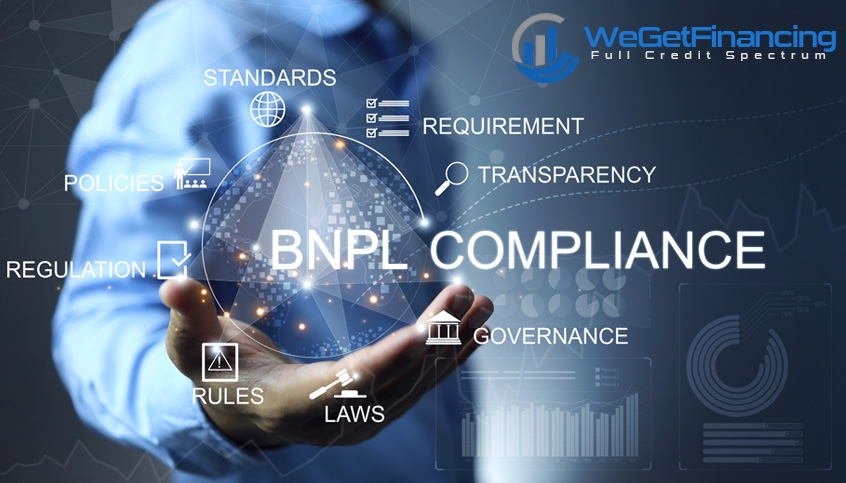The financial landscape is shifting beneath retailers’ feet. What began as a simple alternative payment method has evolved into a complex regulatory environment that demands immediate attention. BNPL regulation is rapidly evolving. Buy Now Pay Later services and consumer financing, once operating in a regulatory gray area, now face the same scrutiny as traditional credit providers.
A New Era of Compliance in Point-of-Sale Financing
For retailers across the spectrum—from corner boutiques to multinational chains—this transformation presents both challenges and opportunities. The central question isn’t whether regulation will affect your business, but how prepared you are to adapt while maintaining the consumer financing options your customers increasingly expect.
The stakes are higher than many realize. Regulatory compliance isn’t just about avoiding penalties; it’s about building sustainable competitive advantages through trustworthy payment solutions that customers can rely on without hesitation.
The Current State of BNPL Regulation WorldWide
“With one in seven Gen Z consumers already maxing out their credit cards, the demand for improved financial literacy and stronger consumer protections is greater than ever.”
— Nandan Sheth, “What New Regulations Mean For Pay Later Industry”, Forbes, May 2024.
BNPL options are gaining traction worldwide, especially among younger digital-native consumers. As usage accelerates, financial authorities in markets like the UK, Australia, and others have started implementing regulations to govern how these alternative payment solutions are offered and disclosed 1.
While local rules vary, clear global trends are emerging: aligning BNPL with traditional credit frameworks, and demanding greater transparency and consumer protection at every stage of the transaction.
BNPL Compliance Trends Around the World
Transparency by Default

No more fine print.
Clear display of terms, fees, and schedules is now mandatory.
Responsible Marketing

No misleading claims.
BNPL promotions must stay honest—especially for youth.
Smarter Credit Checks

No blind approvals.
Credit assessments are tightening to reduce risk.
1. Transparency Requirements Are Expanding
Modern BNPL regulation demands upfront clarity. Retailers must now ensure repayment terms, schedules, and any fees are displayed clearly—no hidden conditions, no fine print.
The goal? Ensure consumers understand the full cost of financing before committing, reducing misunderstandings and regulatory risk.
2. Marketing Standards Face Strict Oversight
Promotional content is under scrutiny—especially when targeting youth or vulnerable consumers. While offering Buy Now Pay Later options, messaging must now be realistic, balanced, and free of misleading claims.
Retailers should review their ads to ensure they communicate not just benefits, but obligations, aligning promotion with regulatory expectations.
3. Credit Assessment Protocols Mirror Traditional Lending
Instant approvals are giving way to more rigorous credit assessments. Providers must now verify consumer financial profiles, similar to banks. For retailers, this could mean slightly slower checkout flows—but with better-qualified buyers and fewer defaults, it’s a long-term win.
In the U.S., the momentum is similar. As younger consumers increasingly adopt BNPL as a primary payment method, regulators are accelerating efforts to bring these services under clearer consumer credit rules.

U.S. BNPL Regulation: What’s Changing in 2025
“Regardless of whether a shopper swipes a credit card or uses Buy Now, Pay Later, they are entitled to important consumer protections under long-standing laws and regulations already on the books.”
— Rohit Chopra, CFPB Director, consumerfinance.gov, May 2024.
Though existing laws already provide key consumer protections, U.S. regulators are shifting from observation to enforcement as the BNPL market expands. Starting mid-2025, both state and federal authorities are implementing or signaling changes that retailers—large and small—will need to follow closely.
Key Developments to Watch
1. New York BNPL Licensing Law (Effective May 2025)
New York becomes the first U.S. state to require Buy Now Pay Later providers to be licensed as lenders, introducing obligations that mirror traditional consumer credit rules:
- Clear disclosure of terms and repayment plans
- Fair dispute resolution practices
- Ban on deceptive or aggressive marketing
Federally chartered banks are exempt, but non-bank and fintech BNPL providers must comply.
2. CFPB Federal Rule Rollback (Ongoing in 2025)
After classifying BNPL as a form of credit card in 2024 (under the Truth in Lending Act), the CFPB is now stepping back:
- It deprioritized enforcement of this rule in early 2025
- There’s talk of full rescission, signaling a softer federal posture toward BNPL for now.
3. Broader Conduct Obligations Coming (June 2025)
While federal rules remain fluid, new industry norms are being codified:
- Transparency on terms, fees, and risks
- Licensing and responsible lending standards for non-bank BNPL providers
- Alignment with consumer credit protections, including the assessment of affordability and clearer pre-contractual disclosures.
Impact for Retailers
| Impact Area | Enterprise Retailers | Small & Mid-Sized Merchants |
|---|---|---|
| Provider Selection | Must vet provider licensing across states | Prefer plug-and-play compliant partners |
| Disclosure Review | Legal/compliance teams revise flows | Rely on provider’s standardized templates |
| Risk Management | Must monitor multi-jurisdiction compliance | More exposed if using unlicensed BNPL |
| Marketing Adaptation | Adjusts targeting language + checkout UX | Must avoid misleading promotions |
Retailers using unlicensed or non-compliant BNPL solutions—even passively—may face customer trust erosion, legal exposure, or operational friction.
The “Compliance Divide”: Large vs. Small Retailers
Strategic actions can help retailers adapt to BNPL regulations—but responses often vary by size. Industry experts call this gap the “compliance divide”.

Large Retailers: Resources and Challenges
Larger retailers often have in-house compliance teams, legal counsel, and IT departments ready to adapt to evolving regulations. They can integrate reporting tools, update disclosures, and maintain audit trails with relative ease.
However, size brings its own challenges. Large retailers often operate across multiple jurisdictions, each with its own regulatory requirements. They must ensure compliance across dozens or hundreds of locations while maintaining consistent customer experiences. The complexity of coordinating these efforts can be overwhelming, even for well-resourced organizations.
Small Retailers: Agility vs. Resources
Independent retailers and small chains face a different set of challenges. While they may lack the resources of their larger counterparts, they often possess greater agility in adapting to regulatory changes. A small retailer can update their POS financing procedures across all locations in a matter of days, while enterprise retailers might require months of planning and implementation.
The primary challenge for smaller retailers lies in interpreting and implementing compliance requirements without dedicated legal or technical support. Many struggle to understand how new regulations apply to their specific situations, particularly when guidance documents are written for larger, more complex operations.
As recent tariff changes have already caused concern, new BNPL regulations add another layer—especially for those relying on consumer financing to offset purchasing slowdowns (see how tariffs and financing can work together). But these shifts reward transparency. Retailers ready to adapt can turn compliance into a trust-building advantage—and leave outdated practices behind.
Consumer Financing as a Strategic Compliance Tool
Beyond avoiding legal risk, smart consumer financing helps retailers build trust. By adding transparent, compliant BNPL options at checkout, they show customers they’re serious about fairness—and unlock real business benefits.
Benefits of transparent & compliant BNPL Tools
Compliance Without
The Chaos

Anticipate upcoming regulatory shifts without scrambling.
Transparent Terms,
Trusted Brand

Improve customer perception of fairness and integrity.
Win Trust.
Stay Ahead

Build long-term trust while staying competitive.
Multi-Lender Platforms: A Strategic Solution for BNPL compliance
One of the most effective strategies for managing regulatory complexity involves partnering with comprehensive payment platforms that handle compliance requirements systematically. A particularly smart move for retailers is choosing a multi-lender BNPL platform with compliance built in by design.
Platforms like WeGetFinancing help retailers stay ahead by offering built-in compliance support, automatic disclosures, and adaptable underwriting rules that align with international consumer finance guidelines.
A BNPL Gateway like WeGetFinancing offers:
Sell More, Worry Less: Compliance Comes Built-In
A smart multi-lender platform turns what could be a legal burden into a plug-and-play consumer financing solution — allowing retailers to offer personalized, flexible terms without needing to act as a financial institution themselves.
This diversity also enables more flexible payment solutions. Different lenders may specialize in different customer segments or product categories, allowing retailers to offer more personalized financing options while maintaining consistent compliance standards.
Another key advantage of an advanced BNPL platform like WeGetFinancing is the built-in anti-fraud infrastructure it provides. Fraud risk can indeed vary dramatically across providers and smart routing can help mitigate it (see Not all BNPL solutions are created equal).
Practical Guidance for Retailers Navigating BNPL Regulation
Whether large or small, merchants should start preparing today. Here’s a practical checklist to keep in mind when navigating BNPL regulation and compliance.
Make sure repayment terms, fees, and total costs are clearly displayed at checkout. BNPL compliance starts with transparency — no hidden conditions, no fine print.
Who carries the legal risk? A compliant BNPL provider should offer built-in disclosures and confirm alignment with state and federal regulations.
Look for a platform that gives you full visibility over transactions, credit checks, and audit logs — especially if you’re operating across multiple locations.
Multi-lender gateways improve approval rates and help spread compliance responsibilities across licensed partners — keeping you agile and protected.
Clear explanations matter. Whether online or offering BNPL in-store, ensure your team understands the financing terms and can communicate them accurately. This helps avoid confusion, build trust, and prevent compliance slip-ups.
For small retailers especially, compliance-ready infrastructure may now be the only way to offer financing without legal risk. Successfully navigating the new regulatory environment requires systematic preparation and ongoing attention to compliance details.
Building Sustainable Consumer Financing Strategies
To sum up, long-term success in the evolving regulatory environment requires retailers to view compliance not as a necessary evil but as a foundation for sustainable growth.

Customer-Centric Compliance
Successful retailers treat BNPL compliance as more than a legal checkbox—it’s a way to improve customer service. Transparent terms and fair assessments build trust, even if the process takes slightly longer.
This approach also supports long-term customer retention and CLV—by reinforcing credibility at every step of the financing journey. (See how customer-centric compliance drives BNPL-powered loyalty and CLV.)

Scalable Infrastructure Investment
Retailers aiming for growth need consumer financing platforms that scale—across states, volumes, and evolving rules. Early investment in the right infrastructure prevents costly retrofits later and ensures BNPL compliance stays intact as complexity rises.
Competitive Advantage : A Level Playing Field — If You Choose the Right Tools
The shift in BNPL regulation is more than a compliance hurdle—it’s a chance for retailers to stand out through transparent, customer-focused innovation.
Those who invest in clear, reliable consumer financing solutions now are better positioned for sustainable growth in a fast-moving market. Retailers who delay or downplay these changes won’t just miss a trend—they’ll miss the trust of tomorrow’s buyers.
The future belongs to retailers who recognize that effective compliance and exceptional customer service aren’t competing priorities—they’re complementary strategies that together create lasting competitive advantages in the modern retail environment.
Ready to stay compliant and competitive?
Join merchants using WeGetFinancing’s multi-lender gateway to offer full-spectrum credit and trusted, regulation-ready BNPL — without the legal headaches.

The WeGetFinancing Editorial Team
Expert insights on BNPL, consumer financing, and retention strategies.
Notes
- Check “Buy-now-pay-later-regulation-around-the-world“, nortonrosefulbright.com ↩︎








